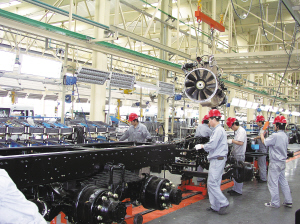Atificial/nutritional Rice Process Line Atificial Rice Process Line,Nutritional Rice Process Line,Golden Rice Maker Machine,Artificial Rice Extruder JINAN CFC MACHINERY CO.,LTD , https://www.cfcmachine.com The level of capacity utilization is directly related to the company's operating costs and profitability. Overcapacity will lead to imbalance in resource allocation, waste and price wars, and may result in operating losses.
The level of capacity utilization is directly related to the company's operating costs and profitability. Overcapacity will lead to imbalance in resource allocation, waste and price wars, and may result in operating losses.
Reduced capacity utilization
It is reported that the monthly sales of Hafei automobile sedan by Changan are less than 1,000, resulting in most of the production capacity of Hafei Automobile Factory being idle. In order to alleviate this problem, Changan Automobile plans to coordinate the transfer of Changan Ford Fiesta to Hafei factory production.
Last year, the Changjiang factory in Jingdezhen, Jiangxi Province, was shut down. Although the fuse is the transfer of production qualifications, the actual analysis in the industry is due to the slowdown in the growth of Changan Automobile and the weakening of growth, which has led to an increase in the sense of instability in the subsidiary.
In fact, the auto companies that had set off a wave of expansion in 2009 are devouring bitter fruits. Galaxy Securities’ recent statistics on production capacity of 36 major passenger vehicle companies show that the capacity of 36 companies increased from 11.73 million units in 2010 to 20.65 million units in 2013. The production capacity of self-owned brands increased from 5.82 million units in 2010 to 10.24 million units in 2013. At the same time, the average capacity utilization rate of the passenger car industry from 2010 to 2012 fell from 110% to 74.5%, of which the utilization rate of the joint venture brands dropped from 120% to 90%, and the utilization rate of self-owned brands decreased from 100% to 58%.
“The decline in capacity utilization is a common phenomenon in the industry. The joint venture brand is still at a reasonable level, and the self-owned brand production rate is lower than the safe level.†Galaxy Securities reported. Some analysts said that 70% to 80% of the capacity utilization rate of auto companies is a reasonable level of safety.
Blind expansion
In contrast, the overall situation of joint-venture car companies is relatively good. The utilization ratios of Shanghai GM, FAW-Volkswagen, and Shanghai Volkswagen, which rank in the top three sales, exceed 110%, and the utilization rate of BMW Brilliance is as high as 154%, with only Dongfeng Nissan and Chang'an Ford and Guangzhou Automobile Toyota are less than 80%.
Expansion sequelae: Average utilization of independent capacity in 2012 58%
At 07:46 on January 14, 2013 Source: First Financial Daily Author: Don Liuyang font size: medium and small print there is such a contrast, with two properties and car companies market their own judgment about. “The joint venture’s plans and plans are much more accurate than the independent brands because they are more accurate in the judgment of the market and in the judgment of their own competitiveness, and there is little difference between planning and actual conditions.†said Chen Wenkai, the independent brand. In addition to the weaker capabilities in these two areas, the joint venture company also suffered more non-market factors, such as local government encouragement.
The "car to the countryside" policy introduced in 2009 was the incentive for the expansion of auto companies. Stimulated by this policy, domestic car sales surged by 46% that year, making it the world's largest auto market. The annual sales volume of many companies increased by more than 50%. According to incomplete statistics, only the mini-vehicle segment, from 2009 to 2012, the production capacity will increase by 150% from 2 million to 5 million vehicles. This part of the new production capacity is almost entirely completed by independent brand companies.
A self-owned car company executive admits to this reporter: “Now it seems that the original expansion was somewhat blind, at least not calm. But it was indeed very contradictory, do not expand production, look at the market so well, seeing Has the market share been snatched away by opponents?†The company decided to give it a go and achieve a significant increase in sales in the short term. However, as originally expected, when the market shrinks, the bitter fruits such as the idleness of equipment and factories, and the tight liquidity have come one after another.
According to Dai Qiang (a pseudonym), a Chinese executive of the Japanese joint venture company, it is a matter of both the autonomy and the joint venture companies that they are very lofty, shouting slogans and ignoring market rules.
In fact, although sales of self-owned brands have increased since September last year, they have only stopped falling and rebounded, and market share has continued to decline year-on-year, which is also lower than the overall growth rate of the passenger vehicle market. From the financial data, in addition to the Great Wall, Chery, Changan, BYD and other companies are on the verge of loss or loss.
Galaxy Securities also made a capacity utilization forecast based on the 2013 production capacity and sales plan of the auto makers. The results show that in 2013, only four companies, including Great Wall, Jianghuai, and Wuling Motors, had capacity utilization rates of more than 60%, and the others were all below. 60%.
At present, many agencies have forecasted that the auto market will achieve a growth rate of more than 10% in 2013, but Dai Qiang said that after realizing that he is still in business after March, he is more pessimistic about the market as a senior manager of sales. It is very likely that there will be zero or even negative growth," said Dai Qiang. If the auto market is still not showing signs of improvement, independent brands and joint-venture car companies with low capacity utilization will face more difficult situations than last year.
Last year, the automotive capacity utilization rate was only 58%